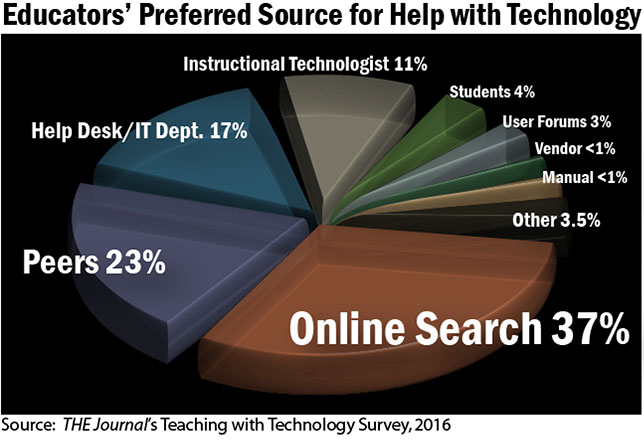Where Do Teachers Turn for Tech Help? Not the Help Desk (Much)
Research shows that teachers prefer to rely on one another to get solutions to technology problems than they do on the IT department.
- By David Nagel, Dian Schaffhauser
- 10/27/16
By a margin of about five to one, teachers prefer to solve their own tech problems without the help of the IT department.
According to a survey of more than 1,300 educators by THE Journal, educators' top choice for solving their tech troubles is online searches, with 37 percent citing that as their preferred source for help with technology. Coming in second was peers, at 23 percent. The help desk/IT department ranked third at 17 percent, followed by the instructional technologist at 11 percent. Students rounded out the top 5 preferred sources of tech help at 4 percent.

But the results don't mean that teachers necessarily feel like they're being stranded. Nearly two-thirds of those surveyed (63 percent) indicated they have adequate support and training for the use of technology in the classroom.
For their part, most teachers said they see themselves as at least competent in their tech abilities. Fifteen percent said they are "absolutely confident" in their tech skills, while 69 percent said they are very confident. Fourteen percent said their tech skills are merely adequate. Less than 3 percent rated their own tech skills as below average or incompetent.
Top Hardware in Use & Teachers' Wish Lists
Teachers are currently using a wide range of technologies in their classrooms, but the top 5 should come as no surprise:
- Desktop computers (80 percent);
- Traditional laptops (77 percent);
- Document cameras (71 percent), tying with cameras and other photographic equipment;
- Interactive whiteboards (68 percent); and
- Non-interactive projectors (65 percent), tying with scanners and multifunction printers.
Among the tech currently not in use in classrooms, six technologies stood out above the rest as most desired by educators:
- 3D scanners (with 31 percent naming these devices to their wish list);
- 3D printers (26 percent);
- Virtual reality gear (23 percent);
- Detachable tablets, such as Microsoft Surface, HP Envy, Lenovo Yoga, etc. (20 percent);
- Tech-enabled student furnishings (19 percent); and
- Interactive large-screen displays (18 percent).
Honorable mention also went to interactive projectors (15 percent), robotics (14 percent), tech-enabled lecterns (14 percent), scientific sensors and probes (13 percent) and e-readers (13 percent). Smart watches, somewhat surprisingly, managed to show up on 10 percent of educators' tech wish lists.
Top Software in Use & Teachers' Wish Lists
As with hardware, there was little surprising about the top 5 software in use in today's classrooms:
- Presentation software, such as PowerPoint, Google Slides, Prezi, etc. (96 percent);
- Word processing (95 percent);
- Gradebook (91 percent);
- Online video services (90 percent); and
- Classroom management software (69 percent).
However, there were some surprises on teachers' wish lists:
- Animation software, at 17 percent, was the most popular wish list item;
- 3D modeling software followed closely behind at 16 percent, perhaps as a natural need has been developing with the introduction of 3D printers in schools;
- 12.5 percent want e-portfolios;
- Tying for fourth were audio editing/mixing software and adapting learning tools at 12 percent each; and
- In fifth place, at 1 percent each, image editing software tied with lecture/screen capture tools.
The Teaching with Technology survey was conducted online in the late spring and early summer months. More than 1,300 qualified respondents (educators working in U.S. K–12 schools) participated, 84 percent of whom work in public schools. Participants skewed to long-timers, with 41 percent saying they've worked in education 21 years or more and 39 percent between 11 and 20 years. The plurality (43 percent) work in secondary schools. Additional details about the survey and methodology can be found in the latest print edition of THE Journal (accessible as a PDF online as well).
About the Authors
David Nagel is the former editorial director of 1105 Media's Education Group and editor-in-chief of THE Journal, STEAM Universe, and Spaces4Learning. A 30-year publishing veteran, Nagel has led or contributed to dozens of technology, art, marketing, media, and business publications.
He can be reached at [email protected]. You can also connect with him on LinkedIn at https://www.linkedin.com/in/davidrnagel/ .
Dian Schaffhauser is a former senior contributing editor for 1105 Media's education publications THE Journal, Campus Technology and Spaces4Learning.